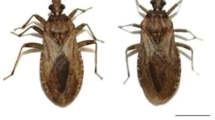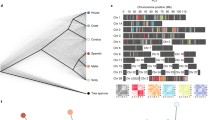Abstract
A cytogenetic analysis has been performed on hybrids, which include F2 and backcross generations, between two chromosomally differentiated taxa of the grasshopper Caledia captiva. These two taxa differ by a series of pericentric rearrangements which involve seven or eight members of the genome (2n=11II+XO/XX). The chromosomally differentiated taxa form a very narrow hybrid zone in S.E. Queensland in which the average change in chromosome frequency is greater than 50% over a distance of only 200 metres. Hybridisation studies were directed towards explaining both the narrowness of the zone and the role of the chromosomal rearrangements in its maintenance. — The F1 generation does not differ from the parental taxa in its fertility or viability. However, the F2 generation is completely inviable and in the backcross generations viability ranges from 0 to 50%. — The inviability in these hybrids results from embryonic breakdown due to arrested development during embryogenesis. In both the F2 and backcross progeny 10 to 20% of the embryos attain full development prior to hatching but fail to emerge from the egg. The persistence of the thick white cuticle is considered to be the factor responsible for the hatching failure and may be related to a malfunction in chitinase production within the pleuropodia, which normally digests this cuticular layer. — Chromosomal analysis of the segregation patterns of the seven autosomal rearrangements among the viable backcross progeny revealed little evidence of any major differential elimination of the rearrangements to account for the observed levels of embryonic mortality. Rather, it is considered that the mortality is induced by the generation of novel, imbalanced recombinant chromosomes by the F1 parent. Whether or not the unbalanced genotypes arise as a consequence of genic substitution differences accumulated during allopatry or an effect of chromosomal heterozygosity, is difficult to distinguish at this stage. However, an analysis of chiasma distribution in F1 males, which are heterozygous for seven autosomal pericentric rearrangements, has shown that the chiasma pattern in these males is very different to that seen in either parents. It is a possibility that this redistribution of chiasmata is responsible for generating novel genotypes which fail to function during embryogenesis. — In terms of the structure of the hybrid zone, the complete failure of the F2 generation provides an immediate explanation for the observed abrupt change in karyotypic frequency of 50% for each of the diagnostic chromosomes. It is considered that the incidence of embryonic breakdown within the hybrid zone will diminish with time due to the survival of some of the backcross progeny which will gradually reduce the frequency of F1 production. — The observed asymmetry of the hybrid zone cannot be explained from the hybridisation data since there is no evidence of differential survival between backcrosses to the Moreton and Torresian parents.
Similar content being viewed by others
References
Ashley, T., Moses, M.J., Solari, A.J.: Electron microscopy analysis of a pericentric inversion in the sand rat (Psammomys obesus). Genetics 91 (suppl.), s2-s3 (1979)
Britten, R.J., Davidson, E.H.: Gene regulation for higher cells: A theory. Science 165, 349–357 (1969)
Brncic, D.: Heterosis and the integration of the genotype in geographic populations of Drosophila pseudoobscura. Genetics 39, 77–88 (1954)
Bruère, A.N.: The segregation patterns and fertility of sheep heterozygous and homozygous for three different Robertsonian translocations. J. Reprod. Fert. 41, 453–464 (1974)
Capanna, E., Gropp, A., Winking, H., Noack, G., Civitelli, M-V.: Robertsonian metacentrics in the mouse. Chromosoma (Berl.) 58, 341–353 (1976)
Carson, H.L.: Reorganisation of the gene pool during speciation. In: Genetics of natural populations, Monogr. III., pp. 274–280. Honolulu: University of Hawaii Press 1973
Cattenach, B.M., Moseley, H.: Non-disjunction and reduced fertility caused by the tobacco mouse metacentric chromosomes. Cytogenet. Cell Genet. 12, 264–287 (1973)
Craddock, E.M.: Chromosomal evolution and speciation in Didymuria. In: Genetic mechanisms of speciation in insects (M.J.D. White, ed.), pp. 24–42. Sydney: A & BZ Book Co. 1974
Craddock, E.M.: Intraspecific karyotypic differentiation in the Australian phasmatid Didymuria violescens (Leach) 1. The chromosomal races and their structural and evolutionary relationships. Chromosoma (Berl.) 53, 1–24 (1975)
Dobzhansky, T.: Speciation as a stage in evolutionary divergence. Amer. Naturalist 74, 404–420 (1940)
Dobzhansky, T.: Genetics of the evolutionary process. New York: Columbia University Press 1970
Dobzhansky, T.: Evolutionary oscillations in Drosophila pseudoobscura In: Ecological genetics and evolution (R. Creed, ed.), pp. 109–133. Oxford: Blackwell, 1971
Fletcher, H.L., Hewitt, G.M.: Non-homologous synaptonemal complex formation in a heteromorphic bivalent in Keyacris scurra (Morabinae, Orthoptera). Chromosoma (Berl.) 65, 271–281 (1978)
Ford, C.E., Hamerton, J.L.: Chromosome polymorphism in the common shrew Sorex araneus. Symp. Zool. Soc. Lond. 26, 223–236 (1970)
Goldschmidt, R.B.: The material basis of evolution. New Haven: Yale University Press 1940
Grant, V.: The architecture of the germ plasm. New York: John Wiley & Sons 1964
Hall, W.P.: Cascading chromosomal speciation and the paradoxical role of contact hybridisation as a sink for gene flow. J. evolut. Theory (in press, 1980)
Hall, W.P., Selander, R.K.: Hybridisation between karyotypically differentiated populations of the Sceloporus grammicus complex (Iguanidae). Evolution (Lawrence, Kans.) 27, 226–242 (1973)
Hubbard, J.P.: The relationships and evolution of the Dendroica coronata complex. AUK 86, 393–432 (1969)
Hunt, W.G., Selander, R.K.: Biochemical genetics of hybridisation in European house mice. Heredity 31, 11–33 (1973)
Jackson, J.F.: The phenetics and ecology of a narrow hybrid zone. Evolution (Lawrence, Kans.) 27, 58–68 (1973)
John, B., King, M.: Heterochromatin variation in Cryptobothrus chrysophorus. 1. Chromosome differentiation in natural populations. Chromosoma (Berl.) 64, 219–239 (1977)
Jones, B.M.: Endocrine activity during insect embryogenesis. Control of events in development following the embryonic moult. (Locusta migratoria and Locusta pardalina, Orthoptera). J. exp. Biol. 33, 685–696 (1956)
Kershaw, A.P.: A long continuous pollen sequence from north-eastern Australia. Nature (Lond.) 251, 222–223 (1974)
Lande, R.: Effective deme sizes during long-term evolution estimated from rates of chromosomal rearrangement. Evolution (Lawrence, Kans.) 33, 234–251 (1979)
Lawrence, C.W.: Genotypic control of chromosome behaviour in Rye. VI. Selection for disjunction frequency. Heredity 12, 127–131 (1958)
Martin, J.: Meiosis in inversion heterozygotes in Chironomidae. Canad. J. Genet. Cytol. 9, 255–268 (1967)
Mayr, E.: Animal species and evolution. Cambridge, Massachusetts: Belknap Press 1963
Moore, J.A.: Further studies on Rana pipiens racial hybrids. Amer. Naturalist 84, 247–254 (1950)
Moran, C.: Population studies of Caledia captiva (Orthoptera: Acridinae) in south-east Queensland. Ph.D. thesis, Australian National University Canberra (1978)
Moran, C.: The structure of the hybrid zone in Caledia captiva. Heredity 42, 13–32 (1979)
Moran, C., Shaw, D.D.: Population cytogenetics of the genus Caledia (Orthopera: Acridinae) III. Chromosomal polymorphism, racial parapatry and introgression. Chromosoma (Berl.) 63, 181–204 (1977)
Moran, C., Wilkinson, P., Shaw, D.D.: Allozyme variation across a narrow hybrid zone in the grasshopper Caledia captiva. Heredity 44, 69–81 (1980)
Mrongovius, M.J.: Cytogenetics of the hybrids of three members of the grasshopper genus Vandiemenella (Orthoptera: Eumastacidae: Morabinae). Chromosoma (Berl.) 71, 81–107 (1979)
Muller, H.J.: Bearing of the “Drosophila” work on systematics. In: New systematics (J.S. Huxley, ed.) Oxford: Clarendon Press 1940
Nix, H.A., Kalma, J.D.: Climate as a dominant control in the biogeography of northern Australia and New Guinea. In: Bridge and Barrier: The natural and cultural history of Torres Strait (D. Walker, ed.). Research School of Pacific Studies publication B9/3, pp. 61–91, Australian National University 1972
Ohno, S.: The preferential activation of maternally derived alleles in development of interspecific hybrids. In: Heterospecific genome interaction (V. Defendi, ed.) Wistar Institute Symp. Monogr. 9, 137–159. Philadelphia: Wistar Institute Press 1969
Ohno, S.: Evolution by gene duplication. Heidelberg, Berlin, New York: Springer 1970
Ohno, S., Stenius, C., Christian, L.C., Harris, C.: Synchronous activation of both parental alleles at the 6-PGD locus of Japanese quail embryos. Biochem. Genet. 2, 197–204 (1968)
Ohno, S., Christian, L., Stenius, C., Castro-Sierra, E., Muramoto, J.: Developmental genetics of the alcohol dehydrogenase locus of the Japanese quail. Biochem. Genet. 2, 361–369 (1969)
Paterson, H.E.H.: More evidence against speciation by reinforcement. S. Afr. J. Sci. 74, 369–371 (1978)
Patton, J.L., Hafner, J.C., Hafner, M.S., Smith, M.F.: Hybrid zones in Thomomys bottae pocket gophers. Genetic, phenetic and ecological concordance patterns. Evolution (Lawrence, Kans.) 33, 860–876 (1979)
Schultz, J., Redfield, H.: Interchromosomal effects on crossing over in Drosophila. Cold Spr. Harb. Symp. quant. Biol. 16, 175–197 (1951)
Shaw, D.D.: Population cytogenetics of the genus Caledia (Orthoptera: Acridinae) I. Inter- and intraspecific karyotype diversity. Chromosoma (Berl.) 54, 221–243 (1976)
Shaw, D.D., Knowles, G.R.: Comparative chiasma analysis using a computerised optical digitiser. Chromosoma (Berl.) 59, 103–127 (1976)
Shaw, D.D., Webb, G.C., Wilkinson, P.: Population cytogenetics of the genus Caledia (Orthoptera: Acridinae). II. Variation in the pattern of C-banding. Chromosoma (Berl.) 56, 169–190 (1976)
Shaw, D.D., Wilkinson, P., Moran, C.: A comparison of chromosomal and allozymal variation across a narrow hybrid zone in the grasshopper Caledia captiva. Chromosoma (Berl.) 75, 333–351 (1979)
Slifer, E.H.: Insect development IV. External morphology of grasshopper embryos of known age and with a known temperature history. J. Morph. 53, 1–22 (1932)
Slifer, E.H.: The origin and fate of the membranes surrounding the grasshopper egg, together with some experiments on the source of the hatching enzyme. Quart. J. microsc. Sci. 79, 493–506 (1937)
Smith, S.G.: Natural hybridisation in the coccinellid genus Chilocorus. Chromosoma (Berl.) 18, 380–406 (1966)
Spirito, F., Modesti, A., Perticone, P., Crustaldi, M., Federici, R., Rizzoni, M.: Studies on mechanisms of fixation and accumulation of centric fusions in natural populations of Mus musculus L. 1. Karyological analysis on a hybrid zone between two populations having 2n=40 and 2n=22 in the central Apennines. Evolution (Lawrence, Kans.) (in press, 1980)
Stam, P.: The existence of stable translocation polymorphisms. Genetica (Den Haag) 50, 149–158 (1979)
Uvarov, B.: Grasshoppers and locusts. Vol. 1. Cambridge: University Press 1966
Valdez, R., Nadler, C.F., Bunch, I.D.: Evolution of wild sheep in Iran. Evolution (Lawrence, Kans.) 32, 56–72 (1978)
Wahrman, J., Goitein, R., Nevo, E.: Mole rat Spalax: Evolutionary significance of chromosome variation. Science 164, 82–84 (1969)
Wallace, A.R.: Darwinism — an exposition of the theory of natural selection with some of its applications. London: McMillan & Co. 1889
Watson, G.F.: The Litoria ewingi complex (Anura: Hylidae) in south-eastern Australia. II. Genetic incompatibility and delimitation of a narrow hybrid zone between L. ewingi and L. paraewingi. Aust. J. Zool. 20, 423–433 (1972)
Webb, G.C.: Chromosome organisation in the Australian plague locust, Chortoicetes terminifera. 1. Banding relationships of the normal and supernumerary chromosomes. Chromosoma (Berl.) 55, 229–246 (1976)
White, M.J.D.: Cytogenetics of the grasshopper Moraba scurra. VI. A spontaneous pericentric inversion. Aust. J. Zool. 9, 784–790 (1961)
White, M.J.D.: Chromosomal rearrangements and speciation in animals. Ann. Rev. Genet. 3, 75–98 (1969)
White, M.J.D.: Animal cytology and evolution. 3rd edit. Cambridge 1973
White, M.J.D.: Speciation in the Australian morabine grasshoppers: The catogenetic evidence. In: Genetic mechanisms of speciation in insects (M.J.D. White, ed.), pp. 57–68 Sydney: A & NZ Book Co. 1974
White, M.J.D.: Modes of speciation. San Francisco: W.H. Freeman 1978
White, M.J.D.: Chain processes in chromosomal speciation. Syst. Zool. 27, 285–298 (1979)
White, M.J.D., Chinnick, L.J.: Cytogenetics of the grasshopper Moraba scurra. III. Distribution of the 15 and 17-chromosome races. Aust. J. Zool. 5, 338–347 (1957)
White, M.J.D., Morley, F.H.W.: Effects of pericentric rearrangements on recombination in grasshopper chromosomes. Genetics 40, 604–619 (1955)
White, M.J.D., Blackith, R.E., Blackith, R.M., Cheney, J.: Cytogenetics of the viatica group of morabine grasshoppers. 1. The “coastal” species. Aust. J. Zool. 15, 263–302 (1967)
Wilson, A.C.: Evolutionary importance of gene regulation. Stadler Symp. 7, 117–134 (1975)
Wright, D.A., Shaw, C.R.: Time of expression of genes controlling specific enzymes in Drosophila embryos. Biochem. Genet. 4, 385–394 (1970)
Author information
Authors and Affiliations
Rights and permissions
About this article
Cite this article
Shaw, D.D., Wilkinson, P. Chromosome differentiation, hybrid breakdown and the maintenance of a narrow hybrid zone in Caledia . Chromosoma 80, 1–31 (1980). https://doi.org/10.1007/BF00327563
Received:
Accepted:
Issue Date:
DOI: https://doi.org/10.1007/BF00327563




